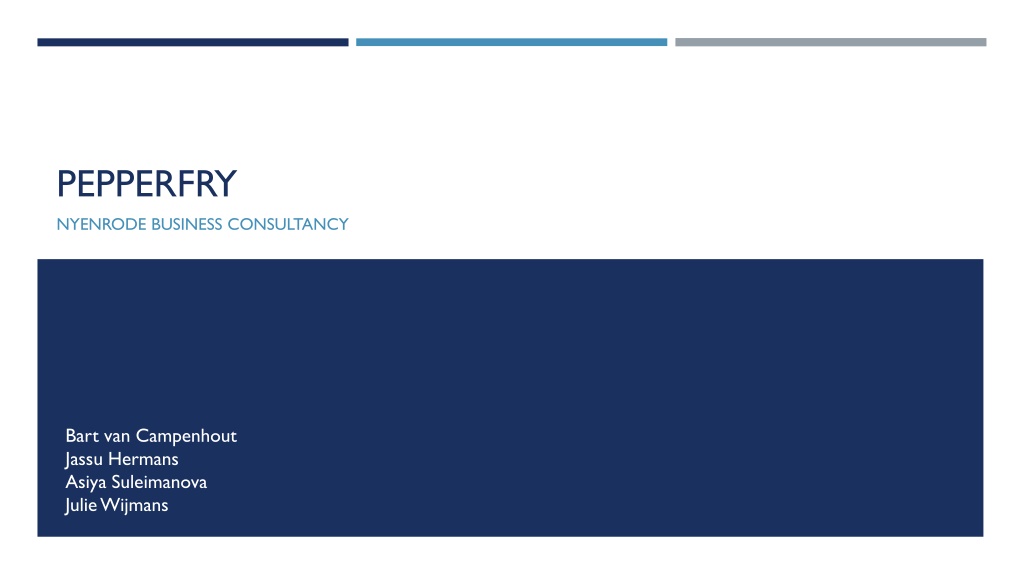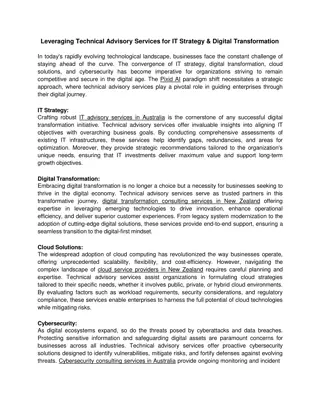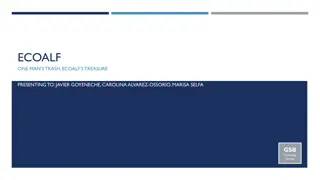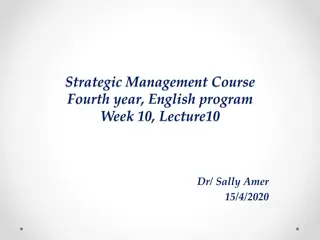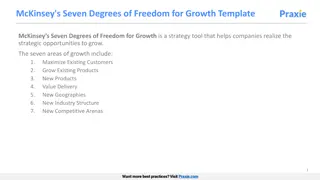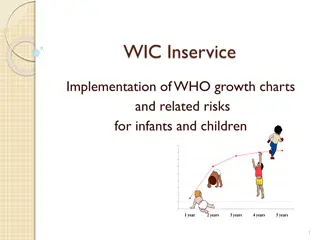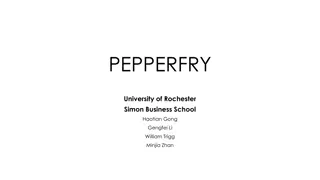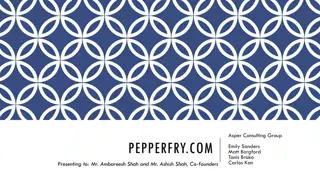Pepperfry Strategy Analysis for Growth
Pepperfry, a leading player in the Indian furniture industry, faces challenges in scaling up and becoming profitable. Key takeaways reveal industry trends and critical challenges. Recommendations include focusing on house brand products and exploring a subscription-based model. The SWOT analysis highlights strengths, weaknesses, opportunities, and threats in Pepperfry's market landscape.
Download Presentation

Please find below an Image/Link to download the presentation.
The content on the website is provided AS IS for your information and personal use only. It may not be sold, licensed, or shared on other websites without obtaining consent from the author.If you encounter any issues during the download, it is possible that the publisher has removed the file from their server.
You are allowed to download the files provided on this website for personal or commercial use, subject to the condition that they are used lawfully. All files are the property of their respective owners.
The content on the website is provided AS IS for your information and personal use only. It may not be sold, licensed, or shared on other websites without obtaining consent from the author.
E N D
Presentation Transcript
PEPPERFRY NYENRODE BUSINESS CONSULTANCY Bart van Campenhout Jassu Hermans Asiya Suleimanova Julie Wijmans
MANDATE Warm welcome to the board of Pepperfry! We are Nyenrode Business Consultancy, presenting to you today the Pepperfry strategy for the next 5 years.
KEY TAKEAWAYS 90% of furniture industry in India is unorganized, highly fragmented and non-branded Logistical problems in India High involvement of Pepperfry throughout entire supply chain Low dependability Pepperfry created a marketplace by mobilizing small artisans (SME furniture makers) 75% of customers come from organic or unpaid traffic sources Furniture industry is expected to grow from $25 to $35 billion in the next 5 years
KEY QUESTION HOW CAN PEPPERFRY SCALE UP AND BECOME PROFITABLE IN THE NEXT 5 YEARS?
CRITICAL CHALLENGES Not enough economics of scale to become profitable Current business model is not scalable Highly challenging furniture market in India Too many value propositions, no clear focus on offerings Packaging difficulties Costly delivery Fierce competition from international players like Ikea
RECAP RECOMMENDATION Short term plan: strategic focus to house brand products. Reduce number of listings of decor. Use current merchants as a physical B&M network to sell our products. Long term: implement a subscription cradle-to-cradle business model to leverage the rental furniture market trend amongst 22-29 year olds.
SWOT S W O T First mover advantage and current market leader Managed to build repeating engagement with customers Highly optimized supply chain and high involvement Established relationships with over 1400 partners Content creation for furniture is not scalable Value proposition has no focus (B&M stores, different furniture types) No clear competition strategy Not yet profitable Rise of rental furniture trend E-commerce marketplace is established as a reliable channel in India Customer focus start to shift to online Indian furniture market is forcasted to grow from $25 BN to $35 BN Subscription model could take off in India Viral marketing could sell out small artisans directly Ikea will sell standardized furniture (as well) Logistical difficulties in India Customers are used to WOM referral in furniture markets 75% organic traffic to website 5.5 million registered users
MARKET ANALYSIS Customer analysis Market challenges Online sales Unorganized Indian internet user base of 450-480 million Highly fragmented 90-100 shopped online Largely non-branded Online Offline Furniture shoppers prefer WOM Logistical problems in India
ANALYSIS Supply chain is relatively optimized, e.g., costs were initially 20-25% of goods sold. Though, Pepperfry is still not profitable. Conclusion: challenge is in the amount of sales, not in SC inefficiencies. Need for upscaling.
ALTERNATIVES OPTIONS FOR UPSCALING 1 2 3 Focusing on home brand category Partner up with incoming entrants Focusing on new additional target group
1 FOCUSING ON HOME BRAND CATEGORY Strategic focus to house brand products. Reduce number of listings. Use current merchants as a physical B&M network to sell our products. Add subscription model in long-term strategy. Create economies of scale Logistic challenge Scalable Invest in creating new Reduces number of home brands listings (and complexity) Increase dependability of Use current merchants merchants network Brings 50% of GMV
2 PARTNER UP WITH INCOMING ENTRANTS Use existing supply chains to partner with incoming entrants Capitalize on their merchandise value Potential growth No empty trucks Increasing dependability Use of current Shift from core focus distribution model
3 FOCUS ON NEW ADDITIONAL TARGET GROUP Sell products to new market Potential growth More marketing costs Other target groups less used to using internet to purchase furniture No need for new SC channels Use of current DC s
DECISION METRICS Scalability GMV SC efficiency Fits Pepperfry DNA (low dependability) Strategic risk
DECISION MATRIX HOME BRANDS PARTNERSHIPS NEW TARGET GROUP Scalability GMV SC efficiency Fits Pepperfry DNA (low dependability) Strategic risk
RECOMMENDATION Focus on implementing home brands by adding 10 additional home brands in the upcoming 5 years
HOME BRANDS As of now, home brand category brings 50% of GMV Enhance value proposition by including 10 additional home brands
IMPLEMENTATION Pepperfry needs to become the online and offline furniture platform by leveraging their local network of merchants and adding a subscription model to their BM
USING THE MERCHANT NETWORK Having own stores not scalable and costly A Indian consumer is not used to travel further than 10 kilometers to a furniture shop Indian consumer expects assembly services Solution: Leverage the local network of merchant to push the home products into the Indian market. The merchants will be used as service points to offer the Indian consumer the service that they are used to Use data to optimize local inventory (product views on website, customer visits and interests in stores)
Category: # of listings Utilities n/a Standard manufacturers INR 1,500 n/a Decor 70, 000 Semi-standard Furniture 10, 000 Non-standard supplier base Avg. selling price % of revenue INR 2,500 20% INR 18,000 80% % of transactions 5%-25% 30%-50% 45%-55% Decrease the # of D cor listings by 50% to 35 000 curated listings Enhance furniture segment by 10 additional home brands in 5 years 100% of revenue comes from D cor and Furniture category Furniture is a leading category bringing 80% of profit However it is difficult to scale as it is non-standard
TARGET AUDIENCE: CASE HYPOTHESES Growing middle class 480 mln Internet users in India 25-30 mln modern, tech-savvy, mobile young professionals residing in booming metros This segment desires self-expression and is highly conscious of their home d cor 5.5 mln registered customers 55-60% of all transactions are lead by repeat customers
HOME BRAND RENTAL SERVICE Furniture rental market is estimated at $3 billion Potential for subscription Pepperfry audience is 30 and above years old Rental is estimated at 22-29 year old > great potential for building relationships early
TARGET AUDIENCE & PERSONA Aviral Gupta 29 years old Challenge Got a job as an IT specialist in an international company head quartered in Mombai Avi needs furniture to settle down in his new apartment, but he does not have a budget to buy expensive furniture Moving out from his home village to kick start his career Found a good apartment for a good price Avi needs the basics: a bed, sofa to host his friends, table to work on his codes and a good lamp to help him go through dark nights Apartment is spacious but unfurnished Avi dreams of moving to Boston in the coming 5 years Rent home brand furniture for a year or more! Solution
FINANCIALS Cost division assumptions 2019 1000 1823 410 2661 5893 m INR Sales marketing Supplying Content marketing costs production costs total 2017 1000 1500 500 1806 4806 2018 1000 1790 469 2193 5452 2020 1000 1853 333 3225 6411 2021 1000 1878 250 3905 7033 2022 1000 1894 172 4724 7790 revenues projection total 2019 4031 403 3628 m INR total subscription sales 2017 2580 2018 3225 161 3064 2020 5039 756 4283 2021 6299 1260 5039 2022 7874 1968 5905 0 2580 Bottom line -2226 -2227 -1862 -1372 -734 84
RISKS What to do with furniture when it s depreciated (>5y)? What to do with furniture that is swapping owners (pressure on logistics)? Would merchants sell our products? Where can we store furniture for rental?
TACKLING RISKS Cradle-to-cradle strategy Transition to next owner by means of contracts Current renter gets discount on next contract if transfers contract to new house owner If customers want to Storage: you have to storage furniture always
CONCLUSION Focus on house brands Sell them through both traditional and subscription models Because they are easily saleable and more profitable in terms of supply chain efficiency and gross margins How can Pepperfry scale up and become more profitable in the next 5 years?
FINANCIAL APPENDICES ratio movements 2019 8.00% 34% 10% % revenues Supply chain costs Gross margin Subscription sales 2017 10% 30% 0% 2018 9.00% 32% 2020 7.00% 36% 15% 2021 6.00% 38% 20% 2022 5.00% 40% 25% 5% Listing runs 2018 63000 12000 75000 2017 70000 10000 80000 2019 56000 14000 70000 2020 49000 16000 65000 2021 42000 18000 60000 2022 35000 20000 55000 D cor House brands Total 2017 2018 4500 161 2019 9000 403 2020 13500 756 2021 18000 1260 2022 22500 1968 subscription sales projection (plans sold) subscription revenues (m INR) subscription refurbishment costs (m INR) 0 0 0 0 0 17.916667 44.791667 83.984375
